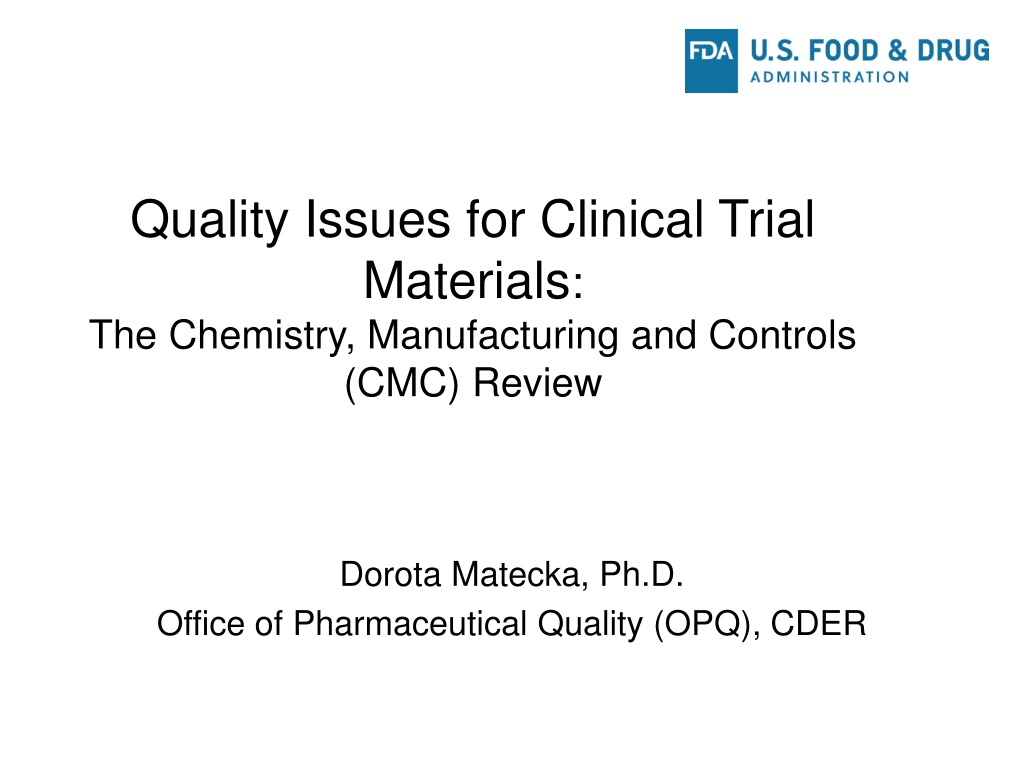Quality Issues in Clinical Trial Materials: CMC Review by Dr. Dorota Matecka
Clinical trial materials undergo Chemistry, Manufacturing, and Controls (CMC) review to ensure pharmaceutical quality. This process includes assessing safety concerns, impurities, and specifications, along with other CMC considerations. Pharmaceutical quality encompasses the suitability, identity, strength, and purity of drug substances or products for their intended use. The challenge lies in replicating the characteristics and performance of clinical batches consistently in commercial batches. Drug substances are active pharmaceutical ingredients (APIs), while drug products are finished dosage forms containing APIs. Key documents such as Investigator Brochure and IND Regulation address the composition, manufacture, and control of drug substances. Overall, maintaining high pharmaceutical quality is essential for the safety and efficacy of drugs throughout the development and manufacturing process.
Download Presentation

Please find below an Image/Link to download the presentation.
The content on the website is provided AS IS for your information and personal use only. It may not be sold, licensed, or shared on other websites without obtaining consent from the author. Download presentation by click this link. If you encounter any issues during the download, it is possible that the publisher has removed the file from their server.
E N D
Presentation Transcript
Quality Issues for Clinical Trial Materials: The Chemistry, Manufacturing and Controls (CMC) Review Dorota Matecka, Ph.D. Office of Pharmaceutical Quality (OPQ), CDER
Outline Pharmaceutical Quality CMC Requirements for INDs CMC Safety Concerns Impurities and Specifications Other CMC Considerations IND Guidance Sources Summary 2
What is Pharmaceutical Quality? The suitability of either a drug substance or drug product for its intended use. This term includes such attributes as the identity, strength and purity (ICH Q6A) The degree to which a set of inherent properties of a product, system or process fulfills requirements (ICH Q9) 4
Pharmaceutical Quality Clinical batches Production Batches Quality Safety Efficacy The challenge for the Quality review and inspection for a New Drug Application is to assure that the characteristics and performance of the clinical batches will be replicated consistently in the commercial batches 5
Drug Substance and Drug Product Drug Substance (Active Pharmaceutical Ingredient, API) An active ingredient, intended for incorporation into a finished dosage form, that meets the statutory definition of a drug (i.e., that is intended to furnish pharmacological activity or other direct effect in the diagnosis, cure, mitigation, treatment, or prevention of disease or to affect the structure or any function of the human body) Drug Product A finished dosage form (e.g., tablet, capsule, or solution) that contains a drug substance, generally but not necessarily in association with one or more other ingredients 21 CFR 314.3 Definitions 6
Investigator Brochure CMC 21 CFR 312.23(a)(5) Investigator s brochure If required under 312.55, a copy of the investigator s brochure, containing the following information: (i) A brief description of the drug substance and the formulation, including the structural formula, if known. 7
IND Regulation 21 CFR 312.23(a)(7)(i) As appropriate for the particular investigations covered by the IND, a section describing the composition, manufacture, and control of the drug substance and the drug product............... ........... sufficient CMC information to assure the proper identification, quality, purity and strength of the investigational drug 8
Identity The structure of the Drug Substance (API) must be proven and controls must be used in the manufacturing process to ensure that the same structure is obtained in every batch The types of techniques or combination of techniques that may be required to fully elucidate the structure depends on the nature of the drug substance 9
Strength (Potency/Assay)* * The drug product needs to contain the required amount of drug substance Assay of the Drug Substance Validated stability-indicating assay or bioassay Assay of the Drug Product Validated stability-indicating assay or bioassay (assay needs to be selective for the drug substance without interference from excipients, impurities, or degradants) Well-controlled manufacturing processes In-Process Blend Uniformity Uniformity of Dosage Units Container Closure System Stability (Expiration Dating Period) 10
Purity Chemical purity (process impurities, degradation products, leachables from container closure system, etc.) Microbiological purity (microbial limits; absence of specific microorganisms, etc.) 11
CMC Regulatory Requirements [21 CFR 312.23(a)(7)] Regulations emphasize the graded nature of CMC information needed as drug development progresses under an IND The amount of information needed depends on: Phase of investigation Dosage form Duration of study Patient population Amount of information otherwise available The emphasis in an initial Phase 1 CMC submission should generally be placed on providing information that will allow evaluation of the safety of subjects in the proposed study 12
Drug Substance Requirements for INDs Description and characterization Manufacturer (name, address, contact information) General method of preparation/synthesis Specification (tests, analytical procedures and acceptance criteria) Batch analysis data for clinical trial batch Stability (through end of clinical trial) 13
Drug Product Requirements for INDs Components Novel excipients may require additional information Quantitative composition Manufacturer (name and address) Description of manufacturing and packaging process Container/closure system Specification (tests, analytical procedures and acceptance criteria) Stability (through end of clinical trial) 14
Other CMC Information Labels and labeling mock-up labels Caution statement that reads: Caution: New Drug Limited by Federal (or United States) law to investigational use. Environmental Assessment Claim for a categorical exclusion Placebo information 15
CMC Safety Concerns (potential hold issues) Product made with unknown or impure components Chemical structures of known or likely toxicity Impurity profile is insufficiently defined or indicates a risk or exceeds levels qualified through toxicology studies Lack of sterility assurance or endotoxin control (e.g., injectable drug products) 16
CMC Safety Concerns (potential hold issues) cont d. Synthesis/manufacturing information provided is insufficient to evaluate the compound claimed is actually manufactured Poor or unknown manufacturing procedures, including compounding Product strength is insufficiently defined Product not stable through clinical study duration Poorly characterized master or working cell bank 17
What is an impurity? Any component of the new drug substance that is not the chemical entity defined as the new drug substance (ICH Q3A) Any component of the drug product that is not the drug substance or an excipient in the drug product (ICH Q3B) 18
Impurities Drug substance impurities Organic impurities (process- and drug related, e.g., starting materials, by-products, intermediates, degradation products, reagents, catalysts) Inorganic impurities (heavy metals or other residual metals, inorganic salts) Residual solvents, polymorphic forms, enantiomeric impurities, extraneous contaminants Drug product impurities Degradation products of the drug substance Reaction products of the drug substance with excipients and/or with immediate container/ closure system 19
Impurities More Toxic than Drug heat MPTP causes chronic irreversible Parkinsonian symptoms Desmethylprodine an opioid analgesic Markey SP, Schmuff NR, Med Res Rev. 1986, 6(4):389-429 20
Impurities Generally limits are based on levels qualified in non- clinical testing DS and DP specifications should include impurity test and acceptance criteria for Individually specified for recurring impurities (if above the identification threshold) General threshold limit for those impurities not individually specified Total impurities Special considerations for potential or known genotoxic impurities 21 21
Specification Defined in ICH Q6A as: a list of tests, references to analytical procedures, and appropriate acceptance criteria, which are numerical limits, ranges, or other criteria for the tests described. It establishes the set of criteria to which a drug substance or drug product should conform to be considered acceptable for its intended use Universal tests described in ICH Q6A for: Drug substance Drug product Includes attributes that serve as surrogates for performance 22
CMC Efficacy Concerns Generally not a reason for a clinical hold Assay uncertainty Uniformity of content Bioavailability 25
Rifampin Bioavailability Particle size Formulation/manufacture Standard product Standard product Process change Excipient change Same process Excipient change Process change R. Cavenaghi, Bull Int Union Tuberc Lung Dis 1989 Mar; 64(1):36-7 26
Use of Foreign Comparators in Clinical Trials* Sample comment: The use of FDA-approved drug products provides assurance of drug quality. Where this is not possible and local products are used, documentation should be provided to show that the drug product is comparable in quality to the US product. Depending on the drug product, this could involve, for example, comparing impurity and dissolution profiles, and content uniformity. *Pre-IND approach recommended 27
Excipients Quality Considerations - Suitability for intended use (target organ/tissue) - Functionality - Compatibility with drug substance - Safety/performance issues - Source (USP/NF; FDA Inactive Ingredients Database) - Excipients of Human or Animal Origins - Novel (new) Excipients* *(1) Guidance for Industry: Nonclinical Studies for the Safety Evaluation of Pharmaceutical Excipients; (2) USP General Chapter <1074> 28
Container Closure System - The sum of packaging components that together contain, protect, and deliver the dosage form (primary and secondary packaging components) - IND should include a brief description of: - The packaging components - The assembled packaging system - Any precautions needed to ensure the protection and preservation of the drug substance and the drug product during the use in the clinical trials 29
Container Closure System - Quality Considerations - Water / Moisture / Humidity - Light - Oxygen - Temperature - Contaminants in primary packaging component - Leachables (primary or secondary component) - Loss of solvent / leak in packaging system - Microbial contamination - Sterility assurance 30
Stability 21 CFR 312.23(a)(7)(ii): stability data are required in all phases of the IND to demonstrate that the drug substance and drug product are within acceptable chemical and physical limits for the planned duration of the proposed clinical investigation The amount of data will depend upon the duration of the proposed clinical study 31
Use of Stability Data To support investigational studies To ensure that the quality and safety of the investigational product is maintained throughout the clinical trial period To obtain impurity profile of the batches used during non-clinical toxicological studies 32
Expiration Dating Period Expiration dating period is not required for the investigational materials Reconstituted products are required to have a use by date CFR 211.137 (g). --- where new drug products for investigational use are to be reconstituted at the time of dispensing, their labeling shall bear expiration information for the reconstituted drug product 33
Clinical Trial Supplies* Examine container integrity on receipt Confirm label s 21 CFR 312.6 compliance Store at recommended conditions Document: Receipt and storage Condition of product on receipt Dosing (including e.g. date & time, lot#, etc) Reconciliation of all product at study conclusion Records kept on-site *See International Conference on Harmonisation of Technical Requirements for Registration Of Pharmaceuticals for Human Use Guidance E6, Guideline for Good Clinical Practice http://bit.ly/E6-GCPs and 21 CFR 312.62 34
IND Guidance Sources Food Drug and Cosmetic Act Code of Federal Regulations (Title 21) 21 CFR 312 (IND content and format) 21 CFR 210 and 211 (CGMP) Guidance FDA ICH 35
FDA IND Guidance Phase 1 (http://bit.ly/IND-Phase-1) Phase 2 & 3 (http://bit.ly/IND-Phase2-3) Meetings (http://bit.ly/IND-meetings) MaPP 6030.1 (http://bit.ly/IND-MaPP) Exploratory IND (http://bit.ly/Expl-IND) GMP for Phase 1 (http://bit.ly/IND-cGMP) 36
Guidance for Industry: CGMP for Phase 1 Investigational Drugs (2008) Frequent questions about GMP expectations for Phase 1 trial materials; clear need for guidance Developed by Agency workgroup (CDER, CBER, ORA) composed of compliance staff, CMC reviewers, and investigators FDA s desire to ensure appropriate quality for early clinical trial material, without impeding drug development Articulates FDA s intent to implement an incremental approach to CGMP compliance for clinical investigational products FDA Guidance issued in 1991 Preparation of Investigational New Drug Products (Human and Animal) (reprinted November 1992) still applies to Phase 2 and Phase 3 clinical trial materials 37
Meetings Pre-IND Meetings EOP2 Meetings Ensure that meaningful and adequate data are generated during Phase 3 studies Identify safety issues, scientific issues and/or potential problems and address/resolve them prior to initiating Phase 3 studies Identify potential roadblocks that could affect review of marketing application Discuss and agree on plans/protocols relative to: Regulations, guidances, and FDA policy Quality by Design (QbD) approaches, if used Pre-NDA Meetings Generally focusing on filing and format issues at least 6 months prior to NDA submission Discussion of any problems that can lead to refuse-to-file recommendation or hinder the review process 38
Summary Sufficient CMC information should be provided in an IND to assure identity, quality, purity and strength of the study drug The level of CMC information increases as development progresses Critical CMC safety issues (including impurities) should be identified - safety concern is the primary reason for placing an IND on clinical hold based on CMC section Other quality issues should be considered and evaluated for INDs CGMP should be applied - Phase 1 drugs do not need full CGMP but do need good manufacturing controls Recommendations of ICH/FDA guidances and input from FDA are helpful during drug development 39
Thank you! 40






















